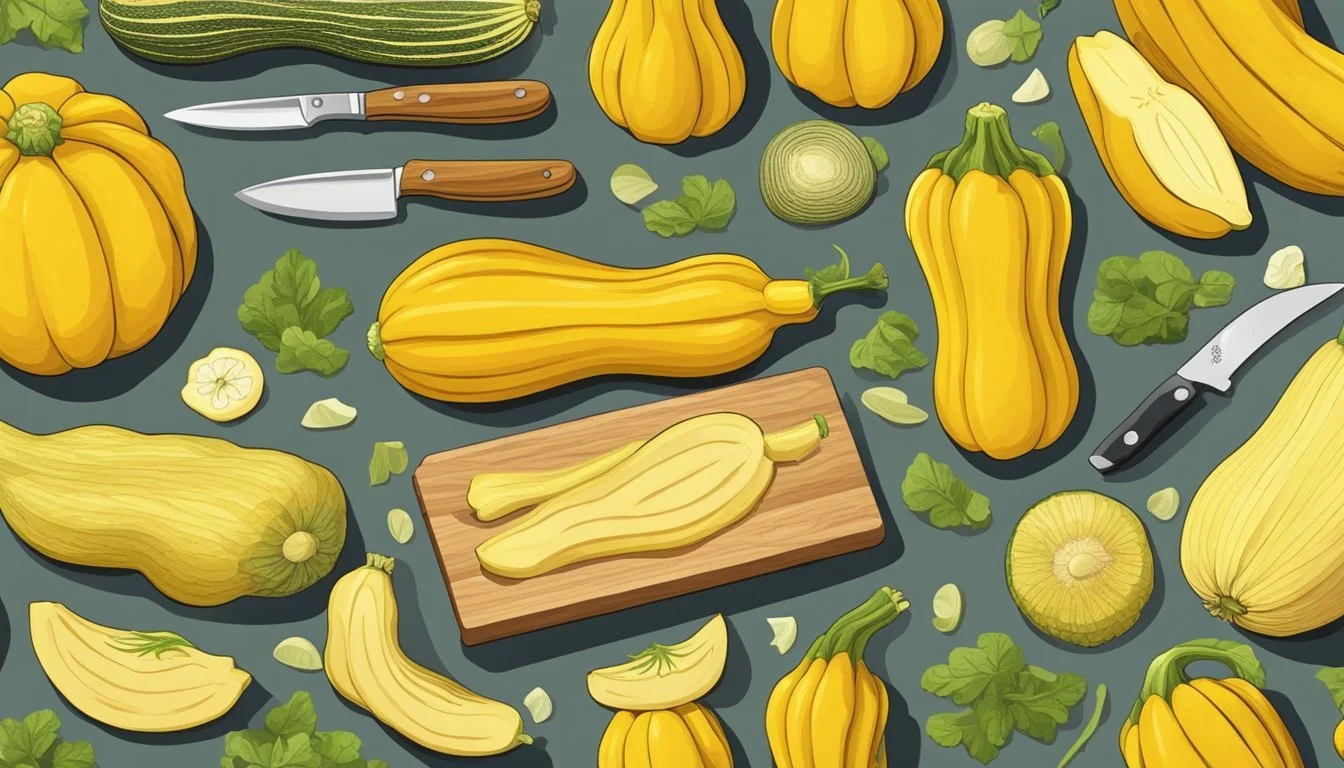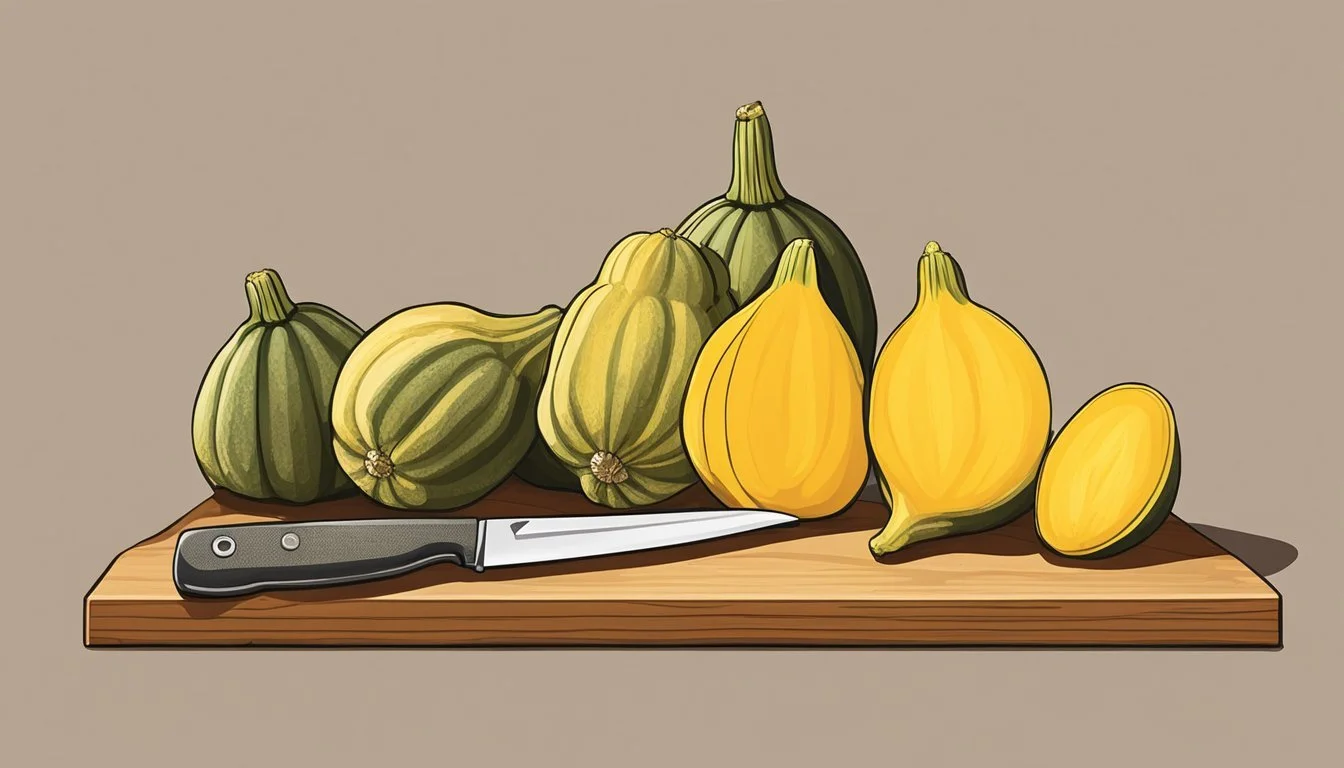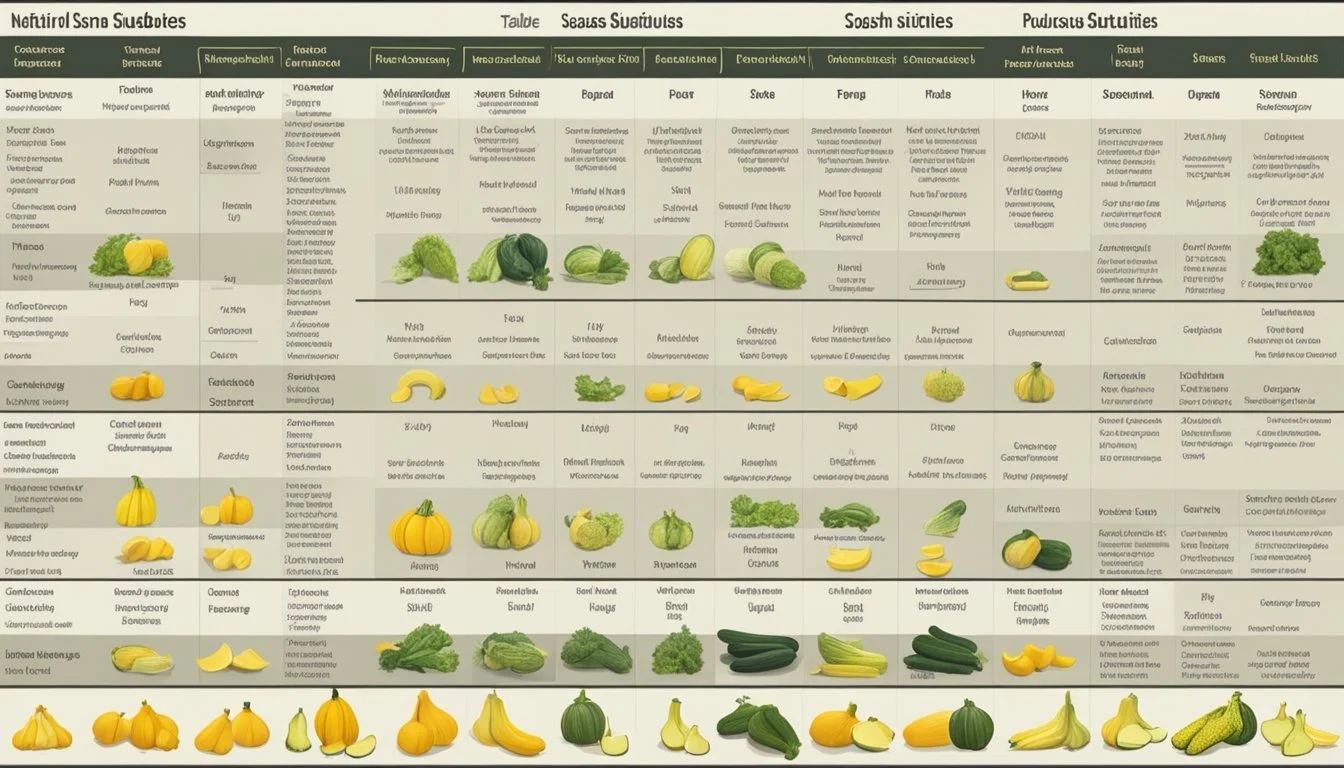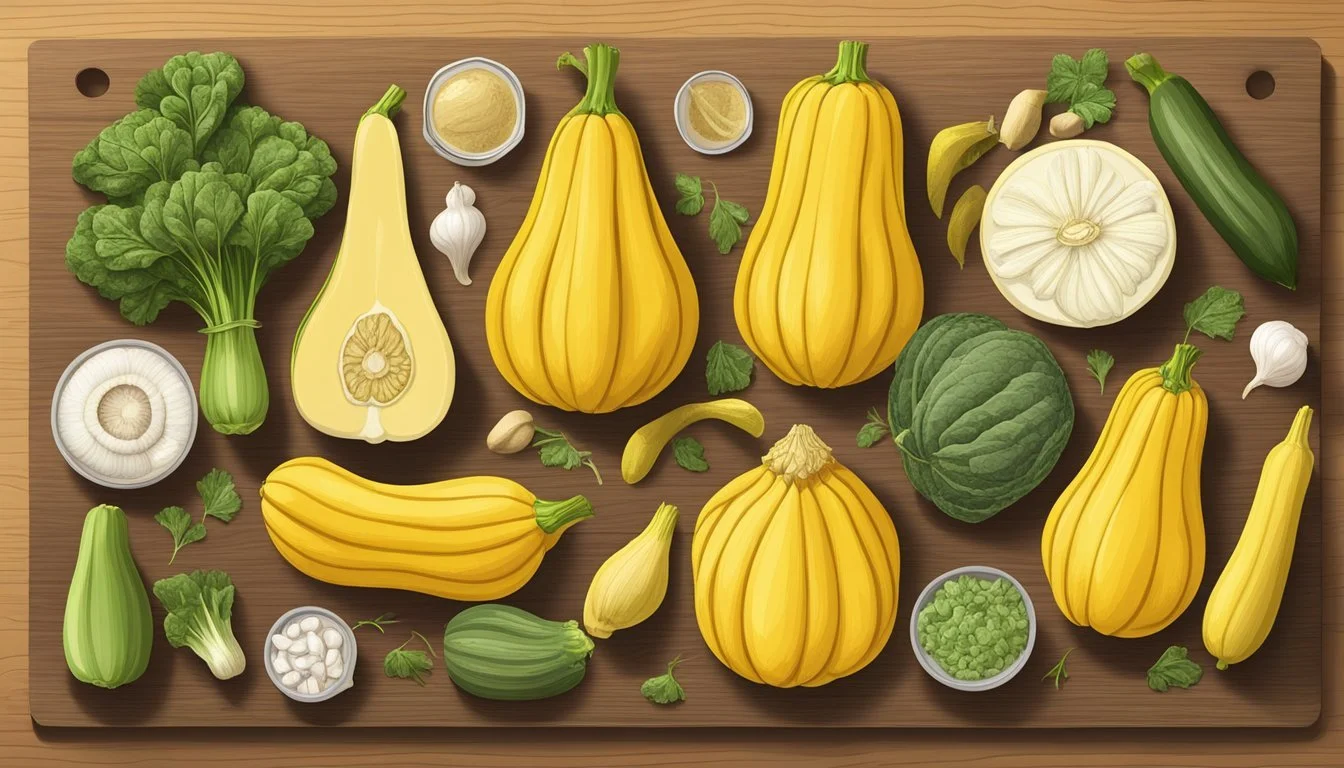Yellow Squash Substitutes
Best Alternatives for Your Recipes
Finding a suitable substitute for yellow squash can elevate your cooking when it's out of season or unavailable. Whether you are preparing a summer salad or a hearty stew, several vegetables can effectively replace yellow squash. Yellow squash can be substituted with zucchini, as they share a similar texture and flavor profile.
Carrots and sweet potatoes also serve as excellent alternatives, bringing a unique twist to your dishes. Their vibrant colors and distinct tastes can enhance both savory and sweet recipes, adding nutritional value with vitamins and antioxidants.
For those looking to maintain the summer squash's flavor, crookneck squash is a close match. This vegetable's earthy taste and texture closely mimic yellow squash, making it a reliable option in various culinary applications.
Understanding Yellow Squash
Yellow squash is a type of summer squash, notable for its vibrant yellow color. Summer squash varieties, including yellow squash, are harvested while still immature, making their skin and seeds tender and edible.
Yellow squash comes in two main varieties: straight neck and crookneck, both of which are rich in nutrients.
Nutrition Information
Yellow squash is low in calories but packed with beneficial nutrients, including:
Vitamins: Particularly high in Vitamin A, Vitamin C, and several B vitamins.
Minerals: Contains potassium, manganese, and magnesium.
Fiber: A good source of dietary fiber, aiding in digestion and maintaining healthy cholesterol levels.
Antioxidants: Rich in lutein and beta-carotene, which help protect the body from free radical damage.
Texture and Flavor
Yellow squash has a slightly sweet and nutty flavor, with a tender texture. It can be used in various dishes such as soups, stews, casseroles, and baked goods. Its delicate skin and flesh make it versatile for both cooked and raw preparations.
Cooking Tips
For baking, yellow squash can be swapped with zucchini in a 1:1 ratio without altering the texture or flavor too much. In soups and stews, it blends well with vegetables like tomatoes, onions, and garlic, adding a vibrant color and subtle taste.
Visual and Culinary Appeal
Yellow squash adds a splash of color to any dish, enhancing both its visual and nutritional appeal. It’s a popular ingredient during the summer months, widely appreciated for its versatility and health benefits.
Common Substitutes for Yellow Squash
When yellow squash is unavailable or you want to try something new, several substitutes offer similar textures and nutritional benefits. This guide explores various substitutes, focusing on vegetables and even some unexpected fruit alternatives.
Zucchini: A Close Relative
Zucchini is often the go-to substitute for yellow squash due to its similar shape, size, and texture.
It can be used in most recipes that call for yellow squash, whether roasted, grilled, or sautéed.
Both zucchini and yellow squash have a mild flavor, making them interchangeable in both savory and sweet dishes.
Use zucchini in casseroles, salads, stir-fries, and even baking.
Zucchini's versatility makes it a staple in kitchens, ensuring it pairs well with many ingredients you might already have.
Winter Squash Varieties
Winter squashes such as butternut squash, acorn squash, and pumpkin can serve as excellent substitutes.
Butternut squash is sweeter but provides a similar firm texture when cooked.
Acorn squash adds a slightly nutty flavor and can be roasted or used in soups.
Pumpkin works well in purees and baked goods, offering nutritional benefits like beta-carotene and fiber.
Winter squashes may require longer cooking times but are rich in nutrients, making them great alternatives for hearty dishes.
Vegetable Alternatives
Other vegetables can also replace yellow squash effectively.
Carrots bring a sweet flavor and bright color, perfect for roasted dishes or stews.
Sweet potatoes have a similar texture and can be used in casseroles and soups.
Eggplant offers a meaty texture and slightly sweet flavor, making it suitable for grilling or baking.
Patty Pan squash is another summer squash with a different shape but similar cooking properties.
Chayote squash is crisp and mild, excellent for raw dishes or light sautéing.
Cucumbers are best used raw in salads or cold dishes due to their high water content.
These vegetables bring their unique flavors, keeping your dishes interesting and varied.
Fruit Substitutes
Fruits might seem unconventional but can also substitute yellow squash in some recipes.
Apples introduce a hint of sweetness and are great for baking or adding to salads.
For a refreshing twist, diced cucumbers add crunch to cold salads and gazpacho.
While fruits like apples can enhance the flavor profile of your dishes, they must be used thoughtfully to balance sweetness with other ingredients.
These substitutes provide options that might already be in your pantry, making them convenient and accessible for your cooking needs.
Substitutions Based on Cooking Methods
When looking for substitutes for yellow squash, various vegetables can be used depending on the cooking method. Each substitute has its unique flavor and texture that can effectively mimic yellow squash in both simple and complex recipes.
Baked and Roasted Dishes
For baked and roasted dishes, butternut squash and sweet potatoes are excellent substitutes. Both offer a slightly sweet flavor and a tender texture when cooked. They can be used in casseroles, roasted vegetable medleys, and baked recipes.
Butternut squash should be peeled and cubed before baking, while sweet potatoes can be sliced or cubed as desired. Toss these substitutes with olive oil, salt, and pepper to enhance their natural sweetness.
Steamed and Boiled Preparations
In steamed and boiled preparations, zucchini and cucumber are great alternatives. Both have a similar water content to yellow squash and become tender when cooked. They work well in soups, stews, and boiled vegetable sides.
Zucchini can be sliced into rounds or diced, while cucumber should be peeled and sliced. Adding them to a stew with tomatoes, onions, and garlic enhances the overall flavor profile.
Grilled Yellow Squash Alternatives
For grilling, eggplant and patty pan squash serve as effective substitutes. Eggplant brings a hearty texture and absorbs marinades well, making it perfect for grilled vegetable skewers. Patty pan squash offers a mild flavor and delicate texture, similar to that of yellow squash, and can be sliced into thick rounds for grilling.
Both substitutes should be brushed with olive oil and seasoned with herbs and spices before grilling. This preparation ensures they remain tender and flavorful.
Sauteed and Stir-Fried Options
In sauteed and stir-fried dishes, carrots and zucchini provide excellent texture and flavor. Carrots, when sliced thin, offer a slight crunch and sweetness, blending well in stir-fries and sauteed dishes. Zucchini softens quickly and takes on the flavors of the other ingredients in the dish.
Both vegetables can be added to stir-fries, sauteed vegetable sides, and salad toppings. Use olive oil or another cooking oil, and season with soy sauce, garlic, and ginger for a flavorful result.
Considerations for Substituting Yellow Squash
When substituting yellow squash in recipes, it's important to consider its unique characteristics.
Yellow squash has a soft, tender texture, making it a suitable swap for ingredients with similar profiles. It can be used in a variety of culinary applications such as soups, salads, and casseroles.
The flavor profile of yellow squash is sweet and mild. This makes it a good match for dishes where a subtle taste is desired. It pairs well with ingredients like tomatoes, onions, and garlic in soups and stews, adding a pleasant flavor without overpowering other elements.
Uses in Dishes:
Salads: Perfect for raw salads, offering a crunchy, refreshing element.
Soups & Stews: Melds well with various vegetables.
Noodles: Great in low-carb or low-calorie dishes, offering a lighter alternative.
Comparison with Other Vegetables:
Vegetable Texture Flavor Profile Best For Zucchini Tender, Soft Mild, Slightly Sweet Baking, Stir-fries, Grilled Dishes Cucumber Crunchy Cool, Mild Salads, Cold Dishes, Sandwiches Carrots Firm Sweet, Earthy Sweet Dishes, Savory Dishes, Roasting
Cooking Tips: Due to its slightly firmer texture, yellow squash might require a longer cooking time compared to zucchini in some dishes. Adjust cooking times accordingly to achieve desired tenderness.
Yellow squash's versatility makes it an excellent substitute in many dishes, from savory to slightly sweet preparations. By understanding its texture and flavor, one can effectively integrate it into various recipes.
Nutritional Profile Comparison
Yellow squash is a nutritious vegetable rich in vitamins, minerals, and fiber. It is often substituted with other vegetables, each offering unique nutritional benefits.
Carrots are a popular alternative. They are high in beta-carotene, which converts to vitamin A in the body. They also contain fiber and provide a good dose of vitamin C and antioxidants.
Sweet Potatoes offer another substitute. They are rich in vitamin A, complex carbohydrates, and fiber. They also provide potassium, which is essential for maintaining heart health.
Pumpkins can replace yellow squash, providing similar nutritional benefits. They are rich in vitamin A, fiber, and antioxidants, which help protect the body from free radicals.
Cucumbers are hydrating substitutes with high water content. They offer a good amount of vitamin K and some fiber but are less calorie-dense than yellow squash.
Here’s a comparison table for better clarity:
Vegetable Key Nutrients Calories (per 100g) Fiber (g) Vitamin A (% DV) Vitamin C (% DV) Potassium (mg) Yellow Squash Vitamin C, Fiber, Magnesium 16 1 4% 35% 262 Carrot Beta-carotene, Fiber, Vitamin C 41 2.8 110% 10% 320 Sweet Potato Vitamin A, Fiber, Potassium 86 3 283% 4% 337 Pumpkin Vitamin A, Fiber, Antioxidants 26 0.5 170% 15% 340 Cucumber Vitamin K, Fiber, Water Content 16 0.5 2% 4% 147
Eggplant serves as a unique substitute with its meaty texture and slightly sweet flavor. It is low in calories and provides a good amount of fiber and antioxidants.
Chayote squash can also substitute yellow squash, especially in raw dishes. It offers a crisp texture, contains vitamin C, and has a low-caloric profile.
Eating a variety of these substitutes can diversify nutrient intake and enhance diet quality.
Vegetable Substitutes in Special Diets
Finding suitable vegetable substitutes for yellow squash can help accommodate various dietary preferences and restrictions. Options vary depending on specific requirements like low-carb, vegan, vegetarian, gluten-free, and paleo diets.
Low-Carb and Keto Diet
For those following a low-carb or keto diet, reducing carbohydrate intake is crucial. Zoodles (zucchini noodles) and spaghetti squash are excellent substitutes for yellow squash due to their similar texture and lower carbohydrate content.
Spaghetti squash in particular can be baked and shredded into spaghetti-like strands. Zoodles can be easily spiralized and used in dishes traditionally made with pasta, providing a familiar texture without the carbs. Cucumbers are another good option for raw salads and cold dishes.
Vegan and Vegetarian Options
In vegan and vegetarian diets, plant-based substitutes for yellow squash need to meet nutritional and textural needs. Eggplant and sweet potatoes work well in many cooked dishes, offering a different but complementary texture and flavor.
Carrots can add a sweet note while still providing a sturdy structure for various recipes. Pumpkins and butternut squash are nutritious options that can be used in soups, stews, and even baked goods. These alternatives maintain a similar profile to yellow squash while fitting into a plant-based diet.
Gluten-Free and Paleo Alternatives
Gluten-free and paleo diets often focus on whole, unprocessed foods that are free from grains and legumes. Spaghetti squash shines in these diets, offering a grain-free option that mimics pasta. Another suitable alternative is buttercup squash, which has a sweet, creamy texture.
Delicata squash, hubbard squash, and acorn squash all provide varied flavors and consistencies appropriate for roasting or incorporating into casseroles. These alternatives ensure dishes remain hearty and satisfying without compromising dietary restrictions.
By understanding the unique characteristics each substitute offers, it's possible to make informed choices that enhance meal planning for specific dietary needs.
Unique Substitutes for Creative Cooking
Incorporating unique substitutes into your cooking can add new dimensions of flavor and texture. A focus on exotic and heirloom varieties and the integration of legumes and grains can transform your culinary creations.
Exotic and Heirloom Varieties
Exotic and heirloom vegetables from the Cucurbitaceae family offer distinct flavors and textures. Asian eggplant, with its slender shape and tender flesh, can be used in stir-fries and ratatouille. Crookneck squash, recognized by its vibrant yellow color and bumpy texture, is another excellent choice for creative dishes.
Examples:
Asian Eggplant: Perfect for stir-fries and grilled dishes.
Crookneck Squash: Ideal for casseroles and salads.
These varieties can replace yellow squash in numerous recipes, enhancing both the visual and taste aspects of your dishes.
Using Legumes and Grains
Legumes and grains introduce new possibilities. Chickpeas and quinoa can replace squash in dishes like stews and casseroles. Quinoa offers a nutty flavor and firm texture, while chickpeas provide a hearty, protein-rich component.
Examples:
Chickpeas: Use in stews and curries.
Quinoa: Ideal for salads and casseroles.
Combining these ingredients with other vegetables like mushrooms and green peppers results in a balanced meal. This approach not only diversifies your menu but also introduces different nutritional benefits.








